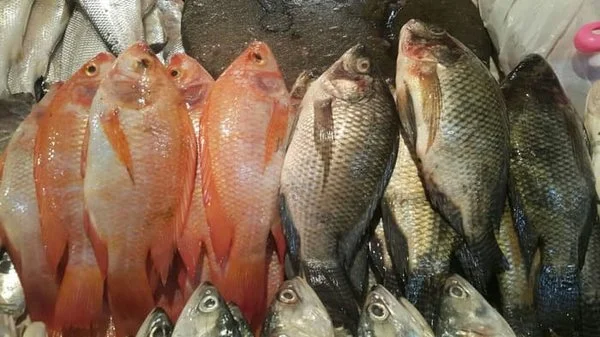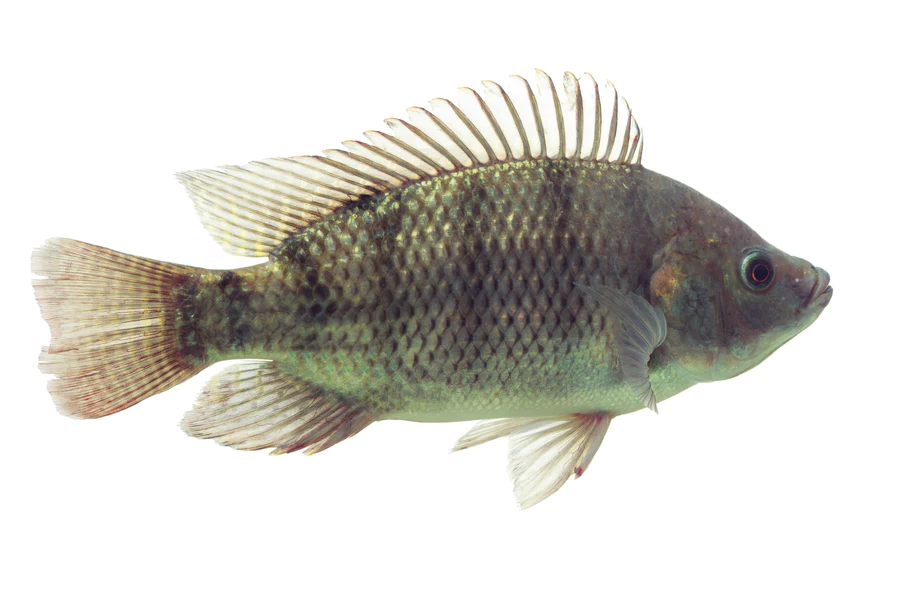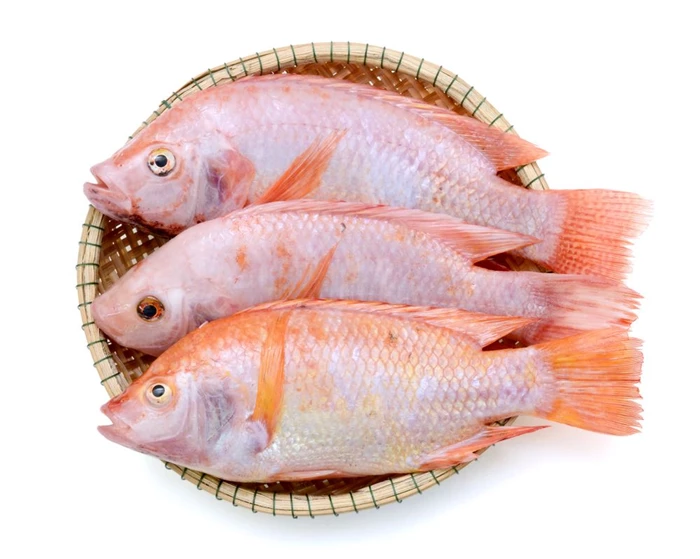The debate regarding the superiority of black tilapia vs red tilapia is endless. This is because the two types of tilapia are very competitive in terms of taste, price, method of cultivation, and market demand. If you want to cultivate one of these fish, please read this article first so you don't make the wrong choice!
Black Tilapia vs Red Tilapia

Black Tilapia
Black tilapia is a cultivated fish that is familiar to many people. Black tilapia is often found live, fresh, or frozen. The types of black tilapia that are often found in the community are local tilapia, GIFT tilapia (GEnetic Improvement of Farmed Tilapia), BEST Tilapia (Bogor Enhanced Tilapia Strains), Nila GESIT (Genetically Supermale Indonesian Tilapia), and Nila Nirvana.
To know more about black tilapia, here are its characteristics:
- Scales are black or gray with white spots around them.
- The flesh is thick, tasty, doesn't smell of mud, and doesn't have fine thorns.
- Larger than red tilapia.
- Superior to red tilapia because there are more types.
- More disease resistant and grow faster.
- Usually cultivated in brackish or sea water.
Red Tilapia
No less popular than black tilapia, red tilapia is much loved by the public because of its own characteristics. Red tilapia is famous for its cleaner appearance when it is processed into food. In Indonesia alone, the types of red tilapia that are often found are larasati tilapia, citralada tilapia, and nifi tilapia.
To know more about red tilapia, here are its characteristics:
- Red or orange with a few black dots.
- Rarely cultivated in brackish or sea water, usually cultivated in fresh water.
- The texture of the meat is not denser than black tilapia, but has not a lot of thorns.
- Some types are resistant to bacteria Streptococcus And Agalactiae.
- Several types are classified as adaptive, so they can be cultivated in various cultivation media such as pools of fast water, still water, KJA, or brackish water ponds.
Black Tilapia Cultivation Techniques vs Red Tilapia

Black tilapia and red tilapia have the same cultivation technique because they are still classified as the same fish group. There is no different cultivation technique from the beginning of cultivation to harvest. In fact, black tilapia and red fish consume the same type of feed.
Want to know how to cultivate black tilapia and red tilapia? Come on, let's see together!
1. Preparation and Making of the Pool
Before starting the cultivation of red tilapia and black tilapia, you should first carry out the pond preparation stage. This is done so that the pond has everything the fish need to support fish growth.
In this stage, first you can determine the location of the pool first. You are advised to choose a strategic location that can be reached by vehicles so as to facilitate the process of buying and selling red tilapia to the market. After the location of the pond is determined, you can start digging a hole to make it a tilapia pond. Ideally, the depth of the tilapia pond is 100-120 cm.
After the pond has been dug, leave the excavation for 3-7 days before the fertilization process. Fertilization is done to grow natural food for tilapia. You are advised to use organic fertilizer at a dose of 1-2 tons per hectare. Fertilizer is spread evenly on the bottom of the pond and then left for 1-2 weeks.
Next, flood the pool with running water as deep as 10-20 cm and let it sit for 3-5 days. Make sure sunlight can penetrate the bottom of the pond so that aquatic organisms can grow. Finally, the pond is filled again with water with a height of 60-75 cm.
2. Selection and Distribution of Livestock Seeds
When you want to start cultivating, you should use male seeds with uniform sizes so that the tilapia can grow faster. The size of the seeds that can be cultivated is 8–12 cm with a stocking density of 10–15 individuals per m2. In addition, you are advised to choose seeds that are healthy, do not have physical disabilities, and can swim agile and agile.
After choosing the seeds that are suitable for cultivation, it's time for the seeds to be slowly spread into the pond so you don't get stressed at night. First, put the seeds in the basin for the adaptation process, then pour the seeds in the basin into the pond.
3. Maintenance
The process of rearing black and red tilapia includes the process of changing water, feed management, and controlling pests and diseases. Replacement of tilapia pond water must be done regularly because it is the most fundamental thing in aquaculture.
Replacement of pond water is done when the water is cloudy and adversely affects the productivity of red tilapia. In this process, tilapia pond water is drained at 1/3 the water level in the pond and then refilled with new water.
The feed management process is no less important because feed accounts for the largest production costs in aquaculture. The schedule for feeding tilapia is carried out in the morning and evening as much as 3% of the body weight of the fish in the aquaculture pond.
The most suitable feed for tilapia is floating pellets because it can facilitate the process of assessing feed quality. If you use sinking pellets, the uneaten feed will be difficult to see and will become ammonia which can poison fish.
Next is pest and disease control. The first step in controlling pests and diseases is to keep the pond clean. This is important to do to prevent ammonia and parasites from infecting fish. If the pond is confirmed to be clean, use water with the appropriate pH in order to prevent disease in tilapia.
4. Harvesting
Tilapia harvest is done when the fish has reached a weight of 300–500 g/head or is around 4–6 months old. To harvest tilapia, first you can open a drainage hole in the pond so the fish can come out and then be caught using the net provided at the disposal gate.
Market Potential for Black Tilapia and Red Tilapia
1. Black Tilapia Market

The trend of consuming black tilapia from year to year in the international market is increasing. In fact, the number of imports of black tilapia in North America and Europe increased to 25%. Indonesia is one of the main exporters of black tilapia to the continent along with China and Taiwan.
In 2004, the national production of black tilapia amounted to 97,116 tonnes, an increase of 2,37% in a period of 4 years. This is also motivated by the rampant cases of KHV (Koi Herpes Virus) in carp, so that black tilapia is an alternative to freshwater fish that are cultivated by the community and one of the mainstays in the fisheries revitalization program.
The business of cultivating black tilapia is indeed very profitable because of the large demand from the international market. Plus, the support from the USDA (US Department of Agriculture), which could make it easier for black tilapia from Indonesia to enter the United States. However, this also needs to be accompanied by efficient cultivation techniques so that black tilapia from Indonesia can face reliable competitors from other countries. With so many requests and types of black tilapia, it is hoped that the increase in production and income of cultivators will occur soon.
2. Red Tilapia Market

Red tilapia is a type of fish that is resistant to deadly diseases, easy to develop, and much in demand by people. This fish also has a wide market share, even being able to compete with the black tilapia market share. This is due to the many improvements to the red tilapia gene so that its quality is more perfect.
Red tilapia is a fish of the future which has very bright prospects. The reason is, since the last 5 years the trend of red tilapia growth has been quite significant with an average increase of 15% per year. Many consumers are tempted by the thick, tasty flesh that is clean white and does not smell of mud, which is owned by red tilapia.
Now more and more cultivators are switching to cultivating red tilapia due to the large market share and selling prices which tend to rise due to the large consumer demand. In 1 month, the amount of red tilapia seeds requested by cultivators from the Seed Center can reach 250 tons. Tilapia is a fish that is very easy for novice cultivators to develop because once the seeds are sown, cultivators can harvest them in less than 1 year.
Currently, red tilapia production in Indonesia can only meet 75% of the local market. Therefore, the red tilapia cultivation business is still wide open for those of you who want to start it.
So, Black Tilapia Cultivation or Red Tilapia?
How are you, sir/madam? Have you decided which tilapia you want to cultivate? When viewed from the texture of the meat, black tilapia has a denser texture than red tilapia. However, black tilapia meat contains more spines than red tilapia.
When viewed from the market potential, the two tilapia have very good market potential in the future. Black tilapia is in great demand by the international market. However, the demand for red tilapia in the country is still large and some have not been fulfilled.
Cultivating black tilapia and red tilapia opens opportunities for many people to become successful cultivators. Even though tilapia is of great interest to the public, if the cultivation is carried out carelessly the losses will come. Therefore, cultivating tilapia must be carried out diligently and thoroughly, sir/madam!
Jika Bapak/Ibu ingin mengembangkan bisnis budidaya ikan nila, Bapak/Ibu bisa menggunakan Kabayan from eFishery. Kabayan is bantuan akses ke lembaga keuangan terpercaya yang diawasi OJK. With Kabayan, Sir/Madam can get feed and other cultivation facilities with a due payment system. Pengajuan Kabayan it's also easy, you can register through the application eFisheryKu.
What are you waiting for? Apply Kabayan dengan mengisi form di bawah!
Fill in your personal data in the following form. Our team will immediately contact you via the number cellphone attached. Make sure the data entered is correct.Get Access to Financial Institutions that are Trusted, Registered & Supervised by OJK!
Questions Regarding Black Tilapia vs Red Tilapia
Yes, red tilapia is a consumption fish that can be eaten.
Black tilapia is a tilapia with grayish-black scales with white spots around them. The type of tilapia belonging to the black tilapia is local tilapia, GIFT tilapia (GEnetic Improvement of Farmed Tilapia), BEST Tilapia (Bogor Enhanced Tilapia Strains), Nila GESIT (Genetically Supermale Indonesian Tilapia), and Nila Nirvana.
- https://www.suaramerdeka.com/gaya-hidup/048331484/ikan-nila-ternyata-gak-cuma-satu-jenis-aja-ini-perbedaan-antara-ikan-nila-merah-dan-ikan-nila-hitam
- https://alfafarm.co.id/blog/budidaya-nila-merah-vs-nila-hitam-keduanya-bikin-pembudidaya-sampit-kepincut/
- https://berempat.com/bisnis/umkm/8798/gurihnya-untung-dari-budidaya-ikan-nila-hitam/
- https://berempat.com/bisnis/umkm/12270/permintaan-ikan-nila-merah-sangat-tinggi/
